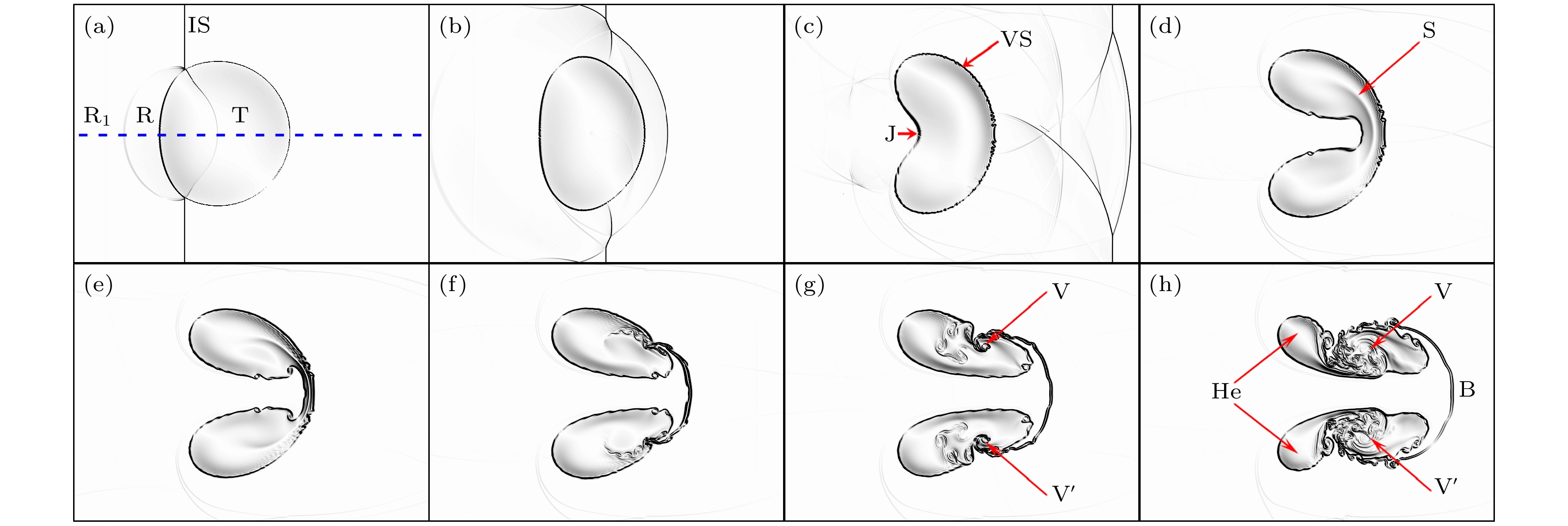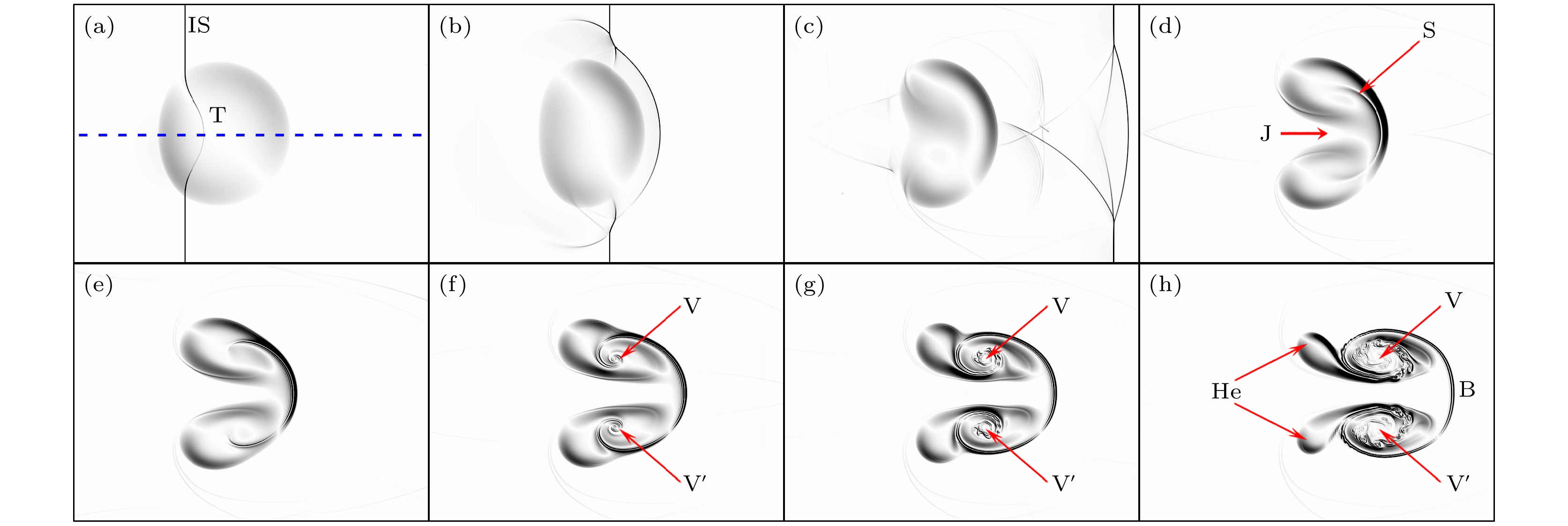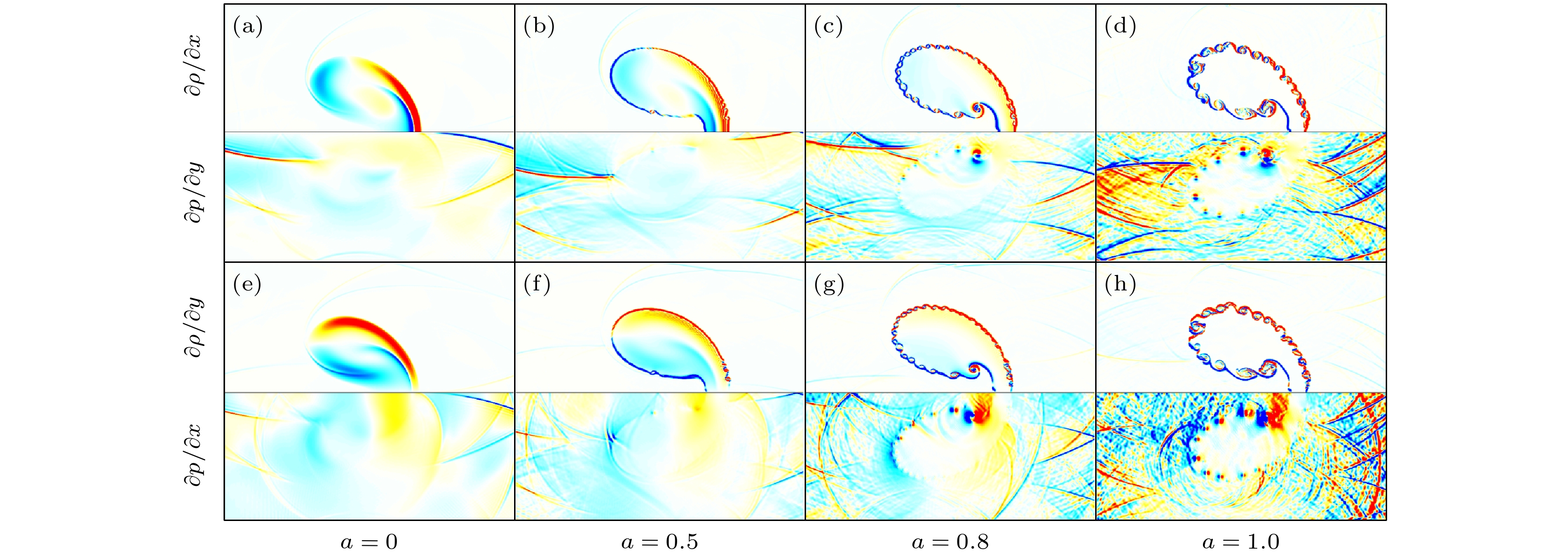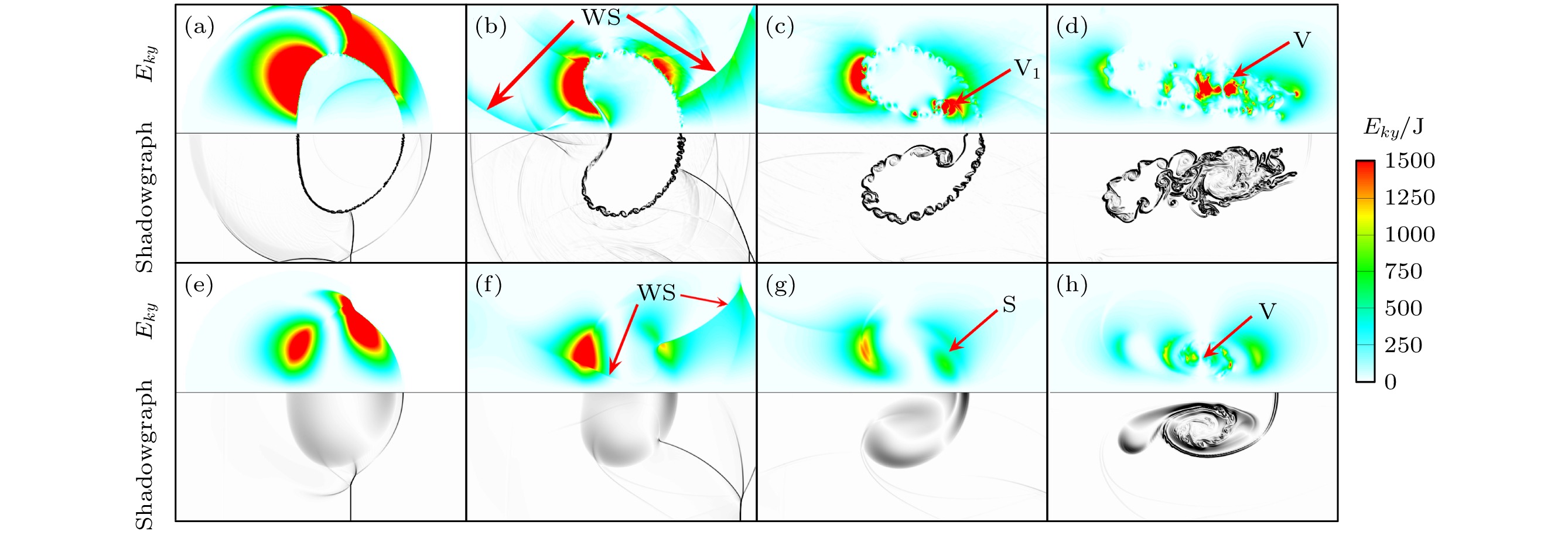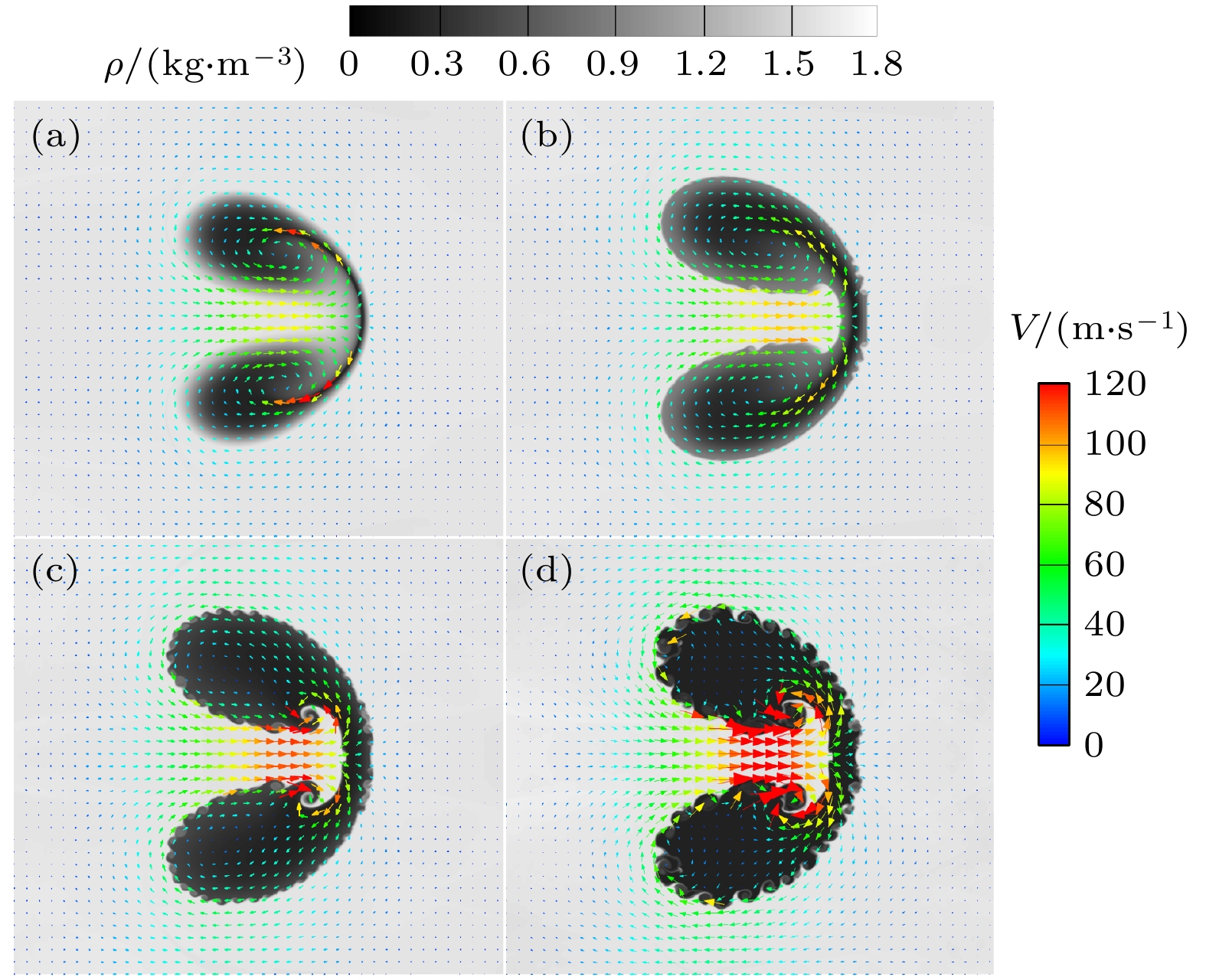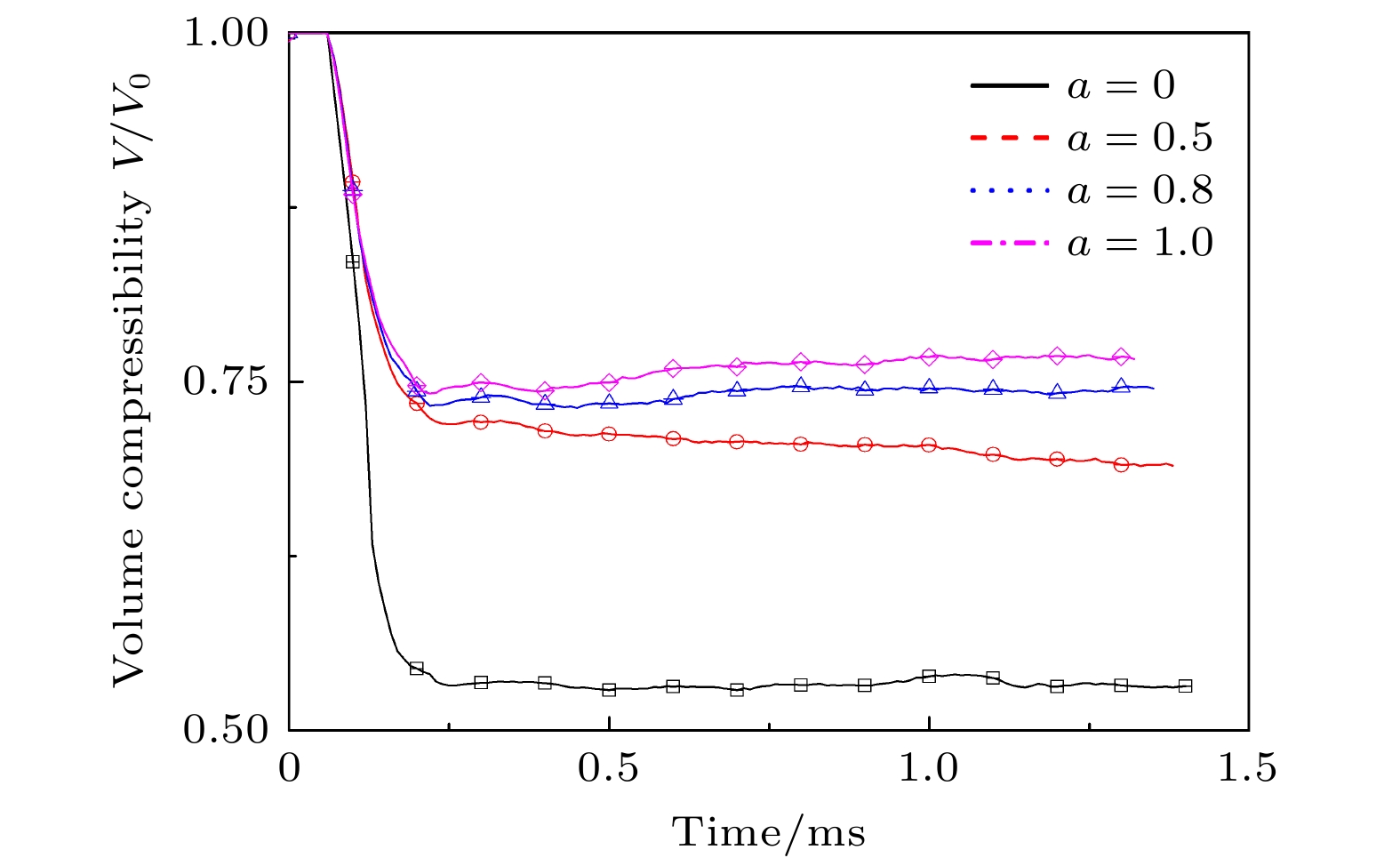-
In this paper, the Richtmyer-Meshkov instability is studied numerically by using the high-resolution Roe scheme based on the two-dimensional unsteady Euler equation, which is caused by the interaction between shock wave and the helium circular light gas cylinder with different component distributions. The numerical results are used to further discuss the deformation process of the gas cylinder and the wave structure of the flow field, and also to quantitatively analyze the characteristic dimensions (length, height and central axial width) of the gas cylinder, the time-dependent volume compression ratio of the cylinder. In addition, the flow mechanism of shock-driven interface gas mixing is analyzed from multiple perspectives by combining the flow field pressure, velocity, circulation and gas mixing rate. Then the effects of different initial component distribution conditions on interface instability are investigated. The results show that when the diffusion interface transforms into the sharp interface, the reflection coefficient gradually increases on both sides of interface. When the incident shock wave interacts with the cylinder, the transmission of the shock wave will transform from conventional transmission into unconventional transmission. At the same time, the reflected shock wave is gradually strengthened and the transmitted shock wave is gradually weakened, which leads the Richtmyer-Meshkov instability to be strengthened. Moreover, the Atwood numbers on both sides of the interface also increase as the diffusion interface transforms into the sharp interface, which leads the Rayleigh-Taylor instability and the Kelvin-Helmholtz instability to be strengthened. Therefore, the increase of instability will cause the circulation to increase, resulting in the increase of the growth rate of gas mixing rate.
-
Keywords:
- Richtmyer-Meshkov instability /
- sharp interface /
- diffusive interface /
- Helium cylinder /
- shock wave
[1] 林震亚, 张焕好, 陈志华, 刘迎 2017 爆炸与冲击 37 748
 Google Scholar
Google Scholar
Lin Z Y, Zhang H H, Chen Z H, Liu Y 2017 Explosion and Shock Waves 37 748
 Google Scholar
Google Scholar
[2] Markstein G H 1957 J Aero Sci. 24 238
[3] Richtmyer R D 1960 Commun. Pure. Appl. Math. 13 297
 Google Scholar
Google Scholar
[4] Meshkov E E 1969 Fluid Dyn. 4 101
 Google Scholar
Google Scholar
[5] Kelvin L 1871 Philos Mag. 150 405
[6] Helmholtz H V 1868 Monthly Reports of the Royal Prussian Academy of Philosophy in Berlin 23 pp215–288
[7] Rayleigh L 1882 Proc. R. Math. Soc. s1-14 170
[8] Taylor S G 1950 Proc. R Soc. London Ser. A 201 192
 Google Scholar
Google Scholar
[9] Lindl J D, Mccrory R L, Campbell E M 1992 Phys. Today 45 32
 Google Scholar
Google Scholar
[10] Balakrishnan K, Menon S 2011 Flow Turbul. Combust. 87 639
 Google Scholar
Google Scholar
[11] Ji S Q, Peng Oh S, Ruszkowski M, Markevitch M 2016 Mon. Not. R Astron. Soc. 463.4 3989
[12] Rudinger G, Somers L M 1960 J. Fluid Mech. 7 161
 Google Scholar
Google Scholar
[13] Haas J F, Sturtevant B 1987 J. Fluid Mech. 181 41
 Google Scholar
Google Scholar
[14] Zhai Z G, Si T, Luo X S, Yang J M 2011 Phys. Fluids. 23 084104
 Google Scholar
Google Scholar
[15] Zhai Z G, Wang M H, Si T, Luo X S 2014 J. Fluid Mech. 757 800
 Google Scholar
Google Scholar
[16] Layes G, Jourdan G, Houas L 2003 Phys. Rev. Lett. 91 174502
 Google Scholar
Google Scholar
[17] Layes G, Jourdan G, Houas L 2005 Phys. Fluids. 17 028103
 Google Scholar
Google Scholar
[18] Layes G, Métayer O Le 2007 Phys. Fluids. 19 042105
 Google Scholar
Google Scholar
[19] Layes G, Jourdan G, Houas L 2009 Phys. Fluids. 21 074102
 Google Scholar
Google Scholar
[20] Wang M H, Si T, Luo X S 2013 Exp Fluids. 54 1427
 Google Scholar
Google Scholar
[21] Luo X S, Wang M H, Si T, Zhai Z G 2015 J. Fluid Mech. 773 366
 Google Scholar
Google Scholar
[22] 范美如, 翟志刚, 司廷, 罗喜盛, 杨基名 2011 中国科学: 物理学 力学 天文学 41 7
 Google Scholar
Google Scholar
Fan M R, Zhai Z G, Si T, Luo X S, Yang J M 2011 Sci. Sin. Phys. Mech Astron. 41 7
 Google Scholar
Google Scholar
[23] 王显圣, 司廷, 罗喜盛, 杨基明 2012 力学学报 4 664
 Google Scholar
Google Scholar
Wang X S, Si T, Luo X S, Yang J M 2012 Acta Mech Sin. 4 664
 Google Scholar
Google Scholar
[24] 沙莎, 陈志华, 薛大文 2013 物理学报 62 144701
 Google Scholar
Google Scholar
Sha S, Chen Z H, Xue D W 2013 Acta Phys. Sin. 62 144701
 Google Scholar
Google Scholar
[25] 沙莎, 陈志华, 张庆兵 2015 物理学报 64 15201
 Google Scholar
Google Scholar
Sha S, Chen Z H, Zhang Q B 2015 Acta Phys. Sin. 64 15201
 Google Scholar
Google Scholar
[26] Ding J C, Si T, Chen M J, Zhai Z G, Lu X Y, Luo X S 2017 J. Fluid Mech. 828 289
 Google Scholar
Google Scholar
[27] 李冬冬, 王革, 张斌 2018 物理学报 67 184702
 Google Scholar
Google Scholar
Li D D, Wang G, Zhang B 2018 Acta Phys. Sin. 67 184702
 Google Scholar
Google Scholar
[28] Jacobs J W 1993 Phys. Fluids A 5 2239
 Google Scholar
Google Scholar
[29] Tomkins C, Kumar S, Orlicz G, Prestridge K 2008 J. Fluid Mech. 611 131
 Google Scholar
Google Scholar
[30] Shankar S K, Kawai S, Lele S K 2011 Phys. Fluids. 23 024102
 Google Scholar
Google Scholar
[31] Zou L Y, Liu C L, Tan D W, Huang W B, Luo X S 2010 J. Vis. 13 347
 Google Scholar
Google Scholar
[32] Zhai Z G, Zhang F, Si T, Luo X S 2014 J. Vis. 17 123
 Google Scholar
Google Scholar
[33] Bai J S, Zou L Y, Wang T, Liu K, Huang W B, Liu J H, Li P, Tan D W, Liu C L 2010 Phys. Rev E. 82 056318
 Google Scholar
Google Scholar
[34] Li D, Wang G, Guan B 2019 Acta Mech. Sin. 35 750
 Google Scholar
Google Scholar
[35] Wan W C, Malamud G, Shimony A, Di Stefano C A, Trantham M R, Klein S R, Shvarts D, Kuranz C C, Drake R P 2015 Phys. Rev. Lett. 115 145001
 Google Scholar
Google Scholar
[36] Giordano J, Burtschell Y 2006 Phys. Fluids. 18 036102
 Google Scholar
Google Scholar
-
图 2 激波(Ma = 1.22)与有膜He气柱作用过程的流场结果(下)与Haas和Sturtevant[13]的实验结果(上)对比
Figure 2. Comparison of Haas and Sturtevant[13] related experimental results (up) with our numerical results (down) for the flow field structure during the interaction of the shock wave (Ma = 1.22) with a cylinder of He gas with a film.
图 4 a = 0.8时, 激波与He气柱作用过程的计算纹影图 (a) t = 0.09 ms; (b) t = 0.15 ms; (c) t = 0.31 ms; (d) t = 0.54 ms; (e) t = 0.65 ms; (f) t = 0.80 ms; (g) t = 0.96 ms; (h) t = 1.25 ms
Figure 4. Numerical schlieren image of the interaction between the shock wave and the He cylinder at a = 0.8: (a) t = 0.09 ms; (b) t = 0.15 ms; (c) t = 0.31 ms; (d) t = 0.54 ms; (e) t = 0.65 ms; (f) t = 0.80 ms; (g) t = 0.96 ms; (h) t = 1.25 ms.
图 8 t = 0.54 ms (上)和1.25 ms (下)时, 流场涡量分布图 (a) a = 0; (b) a = 0.5; (c) a = 0.8; (d) a = 1.0; (e) a = 0, (f) a = 0.5;(g) a = 0.8; (h) a = 1.0
Figure 8. Vorticity distribution at t = 0.54 ms (up) and 1.25 ms (down): (a) a = 0; (b) a = 0.5; (c) a = 0.8; (d) a = 1.0; (e) a = 0; (f) a = 0.5; (g) a = 0.8; (h) a = 1.0.
图 5 a = 1时, 激波(Ma = 1.22)与He气柱作用过程的计算纹影图 (a) t = 0.09 ms; (b) t = 0.15 ms; (c) t = 0.31 ms; (d) t = 0.54 ms; (e) t = 0.65 ms; (f) t = 0.80 ms; (g) t = 0.96 ms; (h) t = 1.25 ms
Figure 5. Numerical schlieren image of the interaction between the shock wave (Ma = 1.22) and the He cylinder at a = 1: (a) t = 0.09 ms; (b) t = 0.15 ms; (c) t = 0.31 ms; (d) t = 0.54 ms; (e) t = 0.65 ms; (f) t = 0.80 ms; (g) t = 0.96 ms; (h) t = 1.25 ms.
图 6 a = 0.5时, 激波与气柱作用过程的计算纹影图 (a) t = 0.09 ms; (b) t = 0.15 ms; (c) t = 0.31 ms; (d) t = 0.54 ms; (e) t = 0.65 ms; (f) t = 0.80 ms; (g) t = 0.96 ms; (h) t = 1.25 ms
Figure 6. Numerical schlieren image of the interaction between the shock wave and the cylinder at a = 0.5: (a) t = 0.09 ms; (b) t = 0.15 ms; (c) t = 0.31 ms; (d) t = 0.54 ms; (e) t = 0.65 ms; (f) t = 0.80 ms; (g) t = 0.96 ms; (h) t = 1.25 ms.
图 7 a = 0时, 激波与气柱作用过程的计算数值纹影图 (a) t = 0.09 ms; (b) t = 0.15 ms; (c) t = 0.31 ms; (d) t = 0.54 ms; (e) t = 0.65 ms; (f) t = 0.80 ms; (g) t = 0.96 ms; (h) t = 1.25 ms
Figure 7. Numerical schlieren image of the interaction between the shock wave and the cylinder at a = 0: (a) t = 0.09 ms; (b) t = 0.15 ms; (c) t = 0.31 ms; (d) t = 0.54 ms; (e) t = 0.65 ms; (f) t = 0.80 ms; (g) t = 0.96 ms; (h) t = 1.25 ms.
图 12 a = 1(上)和0(下)时, 流场纵向动能Eky分布图 (a) t = 0.14 ms; (b) t = 0.25 ms; (c) t = 0.46 ms; (d) t = 1.25 ms; (e) t = 0.14 ms; (f) t = 0.25 ms; (g) t = 0.46 ms; (h) t = 1.25 ms
Figure 12. When a = 1 (up) and 0 (down), cloud plot of the longitudinal kinetic energy Eky of the flow field: (a) t = 0.14 ms; (b) t = 0.25 ms; (c) t = 0.46 ms; (d) t = 1.25 ms; (e) t = 0.14 ms; (f) t = 0.25 ms; (g) t = 0.46 ms; (h) t = 1.25 ms.
图 13 同一阶段, 流场密度分布及速度矢量图 (a) a = 0, t = 0.6 ms; (b) a = 0.5, t = 0.59 ms; (c) a = 0.8, t = 0.51 ms; (d) a = 1.0, t = 0.46 ms
Figure 13. At the same development stage, flow field density distribution and velocity vector diagram: (a) a = 0, t = 0.6 ms; (b) a = 0.5, t = 0.59 ms; (c) a = 0.8, t = 0.51 ms; (d) a = 1.0, t = 0.46 ms.
图 15 不同时刻, 氦气质量分数f_He分布 (a1) a = 0, t = 0.6 ms; (b1) a = 0.5, t = 0.59 ms; (c1) a = 0.8, t = 0.51 ms; (d1) a = 1, t = 0.46 ms; (a2) a = 0, t = 1.25 ms; (b2) a = 0.5, t = 1.25 ms; (c2) a = 0.8, t = 1.25 ms; (d2) a = 1, t = 1.25 ms
Figure 15. Cloud plot of the distribution of helium mass fraction f_He in the flow field at different moments under different initial conditions: (a1) a = 0, t = 0.6 ms; (b1) a = 0.5, t = 0.59 ms; (c1) a = 0.8, t = 0.51 ms; (d1) a = 1, t = 0.46 ms; (a2) a = 0, t = 1.25 ms; (b2) a = 0.5, t = 1.25 ms; (c2) a = 0.8, t = 1.25 ms; (d2) a = 1, t = 1.25 ms.
表 1 气体参数
Table 1. Gas parameters.
气体 密度ρ/(kg·m–3) 比热比
$ \gamma $摩尔质量/(g·mol–1) 当地声速${c}_{ {\rm{A} } }/({\rm{m} }{\cdot}{ {\rm{s} } }^{-2})$ Air 1.176 1.40 28.96 347 He 0.162 1.67 4.00 1021 -
[1] 林震亚, 张焕好, 陈志华, 刘迎 2017 爆炸与冲击 37 748
 Google Scholar
Google Scholar
Lin Z Y, Zhang H H, Chen Z H, Liu Y 2017 Explosion and Shock Waves 37 748
 Google Scholar
Google Scholar
[2] Markstein G H 1957 J Aero Sci. 24 238
[3] Richtmyer R D 1960 Commun. Pure. Appl. Math. 13 297
 Google Scholar
Google Scholar
[4] Meshkov E E 1969 Fluid Dyn. 4 101
 Google Scholar
Google Scholar
[5] Kelvin L 1871 Philos Mag. 150 405
[6] Helmholtz H V 1868 Monthly Reports of the Royal Prussian Academy of Philosophy in Berlin 23 pp215–288
[7] Rayleigh L 1882 Proc. R. Math. Soc. s1-14 170
[8] Taylor S G 1950 Proc. R Soc. London Ser. A 201 192
 Google Scholar
Google Scholar
[9] Lindl J D, Mccrory R L, Campbell E M 1992 Phys. Today 45 32
 Google Scholar
Google Scholar
[10] Balakrishnan K, Menon S 2011 Flow Turbul. Combust. 87 639
 Google Scholar
Google Scholar
[11] Ji S Q, Peng Oh S, Ruszkowski M, Markevitch M 2016 Mon. Not. R Astron. Soc. 463.4 3989
[12] Rudinger G, Somers L M 1960 J. Fluid Mech. 7 161
 Google Scholar
Google Scholar
[13] Haas J F, Sturtevant B 1987 J. Fluid Mech. 181 41
 Google Scholar
Google Scholar
[14] Zhai Z G, Si T, Luo X S, Yang J M 2011 Phys. Fluids. 23 084104
 Google Scholar
Google Scholar
[15] Zhai Z G, Wang M H, Si T, Luo X S 2014 J. Fluid Mech. 757 800
 Google Scholar
Google Scholar
[16] Layes G, Jourdan G, Houas L 2003 Phys. Rev. Lett. 91 174502
 Google Scholar
Google Scholar
[17] Layes G, Jourdan G, Houas L 2005 Phys. Fluids. 17 028103
 Google Scholar
Google Scholar
[18] Layes G, Métayer O Le 2007 Phys. Fluids. 19 042105
 Google Scholar
Google Scholar
[19] Layes G, Jourdan G, Houas L 2009 Phys. Fluids. 21 074102
 Google Scholar
Google Scholar
[20] Wang M H, Si T, Luo X S 2013 Exp Fluids. 54 1427
 Google Scholar
Google Scholar
[21] Luo X S, Wang M H, Si T, Zhai Z G 2015 J. Fluid Mech. 773 366
 Google Scholar
Google Scholar
[22] 范美如, 翟志刚, 司廷, 罗喜盛, 杨基名 2011 中国科学: 物理学 力学 天文学 41 7
 Google Scholar
Google Scholar
Fan M R, Zhai Z G, Si T, Luo X S, Yang J M 2011 Sci. Sin. Phys. Mech Astron. 41 7
 Google Scholar
Google Scholar
[23] 王显圣, 司廷, 罗喜盛, 杨基明 2012 力学学报 4 664
 Google Scholar
Google Scholar
Wang X S, Si T, Luo X S, Yang J M 2012 Acta Mech Sin. 4 664
 Google Scholar
Google Scholar
[24] 沙莎, 陈志华, 薛大文 2013 物理学报 62 144701
 Google Scholar
Google Scholar
Sha S, Chen Z H, Xue D W 2013 Acta Phys. Sin. 62 144701
 Google Scholar
Google Scholar
[25] 沙莎, 陈志华, 张庆兵 2015 物理学报 64 15201
 Google Scholar
Google Scholar
Sha S, Chen Z H, Zhang Q B 2015 Acta Phys. Sin. 64 15201
 Google Scholar
Google Scholar
[26] Ding J C, Si T, Chen M J, Zhai Z G, Lu X Y, Luo X S 2017 J. Fluid Mech. 828 289
 Google Scholar
Google Scholar
[27] 李冬冬, 王革, 张斌 2018 物理学报 67 184702
 Google Scholar
Google Scholar
Li D D, Wang G, Zhang B 2018 Acta Phys. Sin. 67 184702
 Google Scholar
Google Scholar
[28] Jacobs J W 1993 Phys. Fluids A 5 2239
 Google Scholar
Google Scholar
[29] Tomkins C, Kumar S, Orlicz G, Prestridge K 2008 J. Fluid Mech. 611 131
 Google Scholar
Google Scholar
[30] Shankar S K, Kawai S, Lele S K 2011 Phys. Fluids. 23 024102
 Google Scholar
Google Scholar
[31] Zou L Y, Liu C L, Tan D W, Huang W B, Luo X S 2010 J. Vis. 13 347
 Google Scholar
Google Scholar
[32] Zhai Z G, Zhang F, Si T, Luo X S 2014 J. Vis. 17 123
 Google Scholar
Google Scholar
[33] Bai J S, Zou L Y, Wang T, Liu K, Huang W B, Liu J H, Li P, Tan D W, Liu C L 2010 Phys. Rev E. 82 056318
 Google Scholar
Google Scholar
[34] Li D, Wang G, Guan B 2019 Acta Mech. Sin. 35 750
 Google Scholar
Google Scholar
[35] Wan W C, Malamud G, Shimony A, Di Stefano C A, Trantham M R, Klein S R, Shvarts D, Kuranz C C, Drake R P 2015 Phys. Rev. Lett. 115 145001
 Google Scholar
Google Scholar
[36] Giordano J, Burtschell Y 2006 Phys. Fluids. 18 036102
 Google Scholar
Google Scholar
Catalog
Metrics
- Abstract views: 6439
- PDF Downloads: 93
- Cited By: 0















 DownLoad:
DownLoad:





